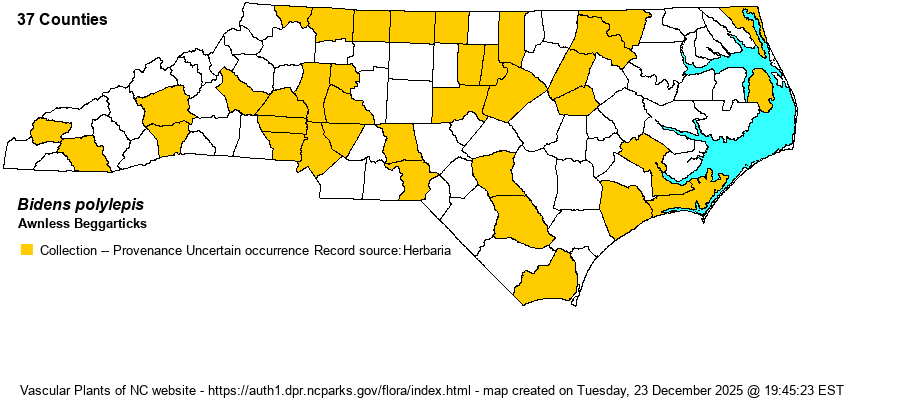| Author | Blake | |
| Distribution | Scattered statewide. Weakley (2020) pulled this taxon back out of B. aristosa, and most references do consider both as valid species. One website editor (Sorrie) disagrees; although extremes can be told apart readily, most cannot with certainty.
Native to the Midwestern states; ranges probably adventitiously east to the East Coast. Weakley (2024) considers it as not native to the Atlantic states. The website editors have decided to be cautious and map the records for now as Provenance Uncertain. | |
| Abundance | Uncommon to infrequent, but easily confused with the very common B. aristosa; thus, true abundance is uncertain. Weakley's (2024) map shows it as "uncommon" in each of the three provinces. | |
| Habitat | "Marshes, wet meadows, ditches, bogs" (Weakley 2020). | |
| Phenology | Flowers and fruits August-October (rarely to November). | |
| Identification | Very similar to B. aristosa, both with large golden-yellow rays. This species has "Calyculus bractlets 12-21, these (6-) 8-12 (20) mm long; calyculus bractlets usually coarsely short-pubescent on the lower surface", whereas B. aristosa has "Calyculus bractlets 8-12 (-16), these (4-) 5-7 (-12) mm long; calyculus bractlets glabrous or fine-pubescent on the lower surface" (Weakley 2020). | |
| Taxonomic Comments | See above. RAB (1968) and most references have listed this as a good species, but Weakley (2018) merged it with B. aristosa; he has since (2020 onward) split it back out again.
| |
| Other Common Name(s) | Ozark Beggarticks, Midwestern Beggarticks | |
| State Rank | SE? | |
| Global Rank | G5 | |
| State Status | | |
| US Status | | |
| USACE-agcp | | |
| USACE-emp | | |

